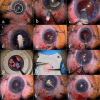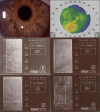Endothelial keratoplasty: clinical outcomes in the two years following deep lamellar endothelial keratoplasty (an American Ophthalmological Society thesis)
- PMID: 18427629
- PMCID: PMC2258101
Endothelial keratoplasty: clinical outcomes in the two years following deep lamellar endothelial keratoplasty (an American Ophthalmological Society thesis)
Abstract
Purpose: To evaluate the clinical outcome of small-incision, deep lamellar endothelial keratoplasty (DLEK) for the treatment of endothelial dysfunction.
Methods: A prospective series of 79 eyes that underwent DLEK by a single surgeon was evaluated. Best spectacle-corrected visual acuity (BSCVA), refractive astigmatism, and central endothelial cell density (ECD) were measured preoperatively and at 6, 12, and 24 months.
Results: Data was available on 78 eyes (99%) at 6 months, 77 eyes (97%) at 1 year, and 79 eyes (100%) at 2 years. Mean BSCVA preoperatively of 20/71 improved to 20/42 by 6 months and remained stable. Eliminating eyes with known retinal disease, BSCVA of 20/40 or better was present in 60% (40 of 67) of eyes at 6 months, 74% (49 of 66) of eyes at 1 year, and 79% (53 of 68) of eyes at 2 years. Refractive astigmatism preoperatively was .91 +/-.78 diopters and was unchanged by surgery over time with results at 6 months of 1.11 +/-.76 (P = .052, power = .43), 1 year 1.04 +/-.80 (P =.287, power = .06), and 2 years 1.10 +/-.70 (P =.467, power = .22). The mean donor ECD preoperatively was 2819 +/- 225 (2389 to 3385) cells/mm(2), and this decreased by 26% at 6 months (2095 +/- 380) (1097 to 2920) (P = .0001; 95% confidence interval [CI] = 643-809), 3% fewer at 1 year (2009 +/- 393) (612 to 2723) (P = .054, power = .5), and 17% fewer at 2 years (1536 +/- 547) (500 to 2546) (P < .001, 95% CI = 368-585). Complications included one primary graft failure and 4 dislocations into the anterior chamber.
Conclusions: DLEK provides improved vision and minimal refractive astigmatic change, but progressive ECD decrease over time is of concern.
Figures




References
-
- Zirm E. Eine erfolgreiche totale Keratoplastik. Arch Ophthalmol. 1906;64:580–593.
-
- Zirm ME, Mannis AA. Eduard Zirm 1863–1944. In: Mannis MJ, Mannis AA, editors. History of Ophthalmology—Corneal Transplantation: A History in Profiles. Vol. 6. Belgium: J.P. Wayenborgh; 1999. pp. 129–141.
-
- Sugar A, Sugar J. Techniques in penetrating keratoplasty: a quarter century of development. Cornea. 2000;19:603–610. - PubMed
-
- Melles GR, Lander F, van Dooren BR, et al. Preliminary clinical results of posterior lamellar keratoplasty through a sclerocorneal pocket incision. Ophthalmology. 2000;107:1850–1856. - PubMed
-
- Terry MA. Deep lamellar endothelial keratoplasty (DLEK): pursuing the ideal goals of endothelial replacement. EYE. 2003;17:982–988. - PubMed
Publication types
MeSH terms
LinkOut - more resources
Full Text Sources
Medical
